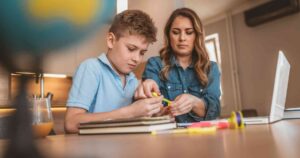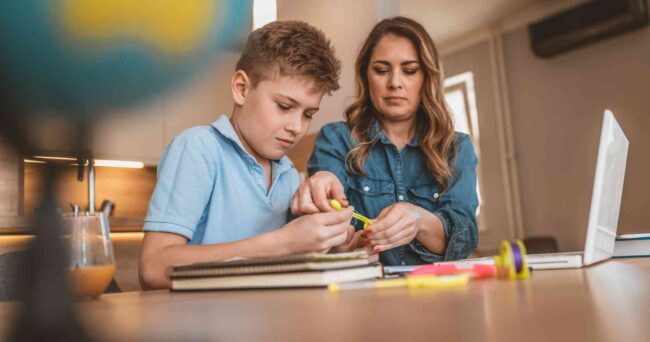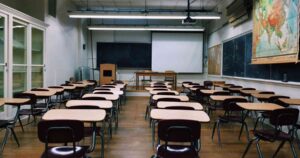Positive Learning Environment: Powerful Strategies
A positive learning environment sets the stage for effective teaching and learning. It encompasses various aspects such as the physical space, classroom culture, relationships between students and teachers, and the overall atmosphere. By creating a positive learning environment, teachers can maximize student engagement, promote academic growth, and nurture social-emotional development.

In order to cultivate a positive learning environment, educators can implement the following strategies:
The Importance of a Positive Learning Environment
A positive learning environment is paramount to students’ academic success and overall well-being. When students feel safe, supported, and valued in their classroom, they are more likely to be engaged, motivated, and open to learning. A positive learning environment sets the stage for effective teaching and learning experiences, as it creates a space where students feel comfortable taking risks, asking questions, and expressing their ideas. It also promotes positive social interactions, enhances student-teacher relationships, and fosters a sense of belonging. In such an environment, students can thrive academically, develop critical thinking skills, and cultivate a lifelong love for learning.
Establishing Clear Expectations and Classroom Rules
One crucial aspect of creating a positive learning environment is establishing clear expectations and classroom rules. When expectations are clearly communicated, students know what is expected of them academically and behaviorally. By setting explicit guidelines for behaviour, participation, and academic performance, teachers provide students with a sense of structure and predictability. This clarity helps to create a harmonious and focused classroom environment, where students understand the boundaries and feel empowered to meet the expectations set before them. Clear expectations and rules also contribute to a sense of fairness, as students understand that everyone is held to the same standards, fostering a positive and inclusive learning environment for all.
Building Positive Relationships with Students
Building positive relationships with students is a cornerstone of creating a positive learning environment. When teachers establish meaningful connections with their students, they create a sense of trust, respect, and rapport. This connection allows students to feel comfortable approaching their teacher with questions, concerns, or ideas.
Positive teacher-student relationships also contribute to a sense of belonging, as students feel seen, heard, and valued in the classroom. By getting to know their students on an individual level, teachers can better understand their strengths, challenges, and interests, allowing for personalized instruction and support. Cultivating positive relationships with students sets the stage for a positive and inclusive classroom culture where students feel motivated, supported, and eager to learn.
Fostering Student Engagement
Student engagement is a key factor in creating a positive learning environment. When students are engaged in their learning, they are active participants in the educational process, taking ownership of their learning and making meaningful connections with the content. To foster student engagement, teachers can employ a variety of strategies. One effective approach is to make learning relevant and meaningful by connecting the curriculum to students’ lives, interests, and real-world applications. Providing hands-on activities, interactive discussions, and opportunities for collaboration also promotes engagement. Additionally, incorporating technology, multimedia resources, and varied instructional methods can captivate students’ attention and cater to different learning styles. By prioritizing student engagement, teachers create an environment where learning becomes exciting, enjoyable, and empowering.

Encouraging Growth Mindset
Fostering a growth mindset is an essential component of creating a positive learning environment. A growth mindset is the belief that intelligence, abilities, and talents can be developed through effort, practice, and resilience. By promoting a growth mindset in the classroom, teachers help students develop a positive attitude toward challenges, view mistakes as learning opportunities, and embrace a love for learning.
Teachers can encourage a growth mindset by providing constructive feedback that focuses on effort and improvement rather than solely on outcomes. They can also teach students about the brain’s plasticity, emphasizing that intelligence is not fixed, and abilities can be developed with dedication and perseverance. Cultivating a growth mindset in students fosters resilience, self-belief, and a willingness to take on challenges, ultimately creating a positive learning environment where students strive for continuous improvement.
Implementing Differentiated Instruction
Differentiated instruction is a valuable strategy for creating a positive learning environment that meets the diverse needs of students. Recognizing that learners have unique abilities, learning styles, and interests, differentiated instruction involves tailoring teaching methods, materials, and assessments to accommodate individual differences. By providing multiple pathways for learning, teachers ensure that all students have opportunities to engage with the content in ways that are meaningful and accessible to them.
Differentiated instruction can include varying instructional strategies, offering choices in assignments and assessments, and providing additional support or enrichment based on individual needs. By embracing differentiation, teachers create an inclusive and supportive classroom environment where all students can thrive and succeed.
Promoting Active Learning Strategies
Active learning strategies are instrumental in creating a positive learning environment that fosters student engagement and deeper understanding. Active learning shifts the focus from a passive, teacher-centred approach to a student-centred approach, where students are actively involved in the learning process. By incorporating activities such as discussions, group work, problem-solving tasks, and hands-on experiments, teachers create opportunities for students to actively construct knowledge, collaborate with peers, and apply concepts in real-life contexts. Active learning strategies also promote critical thinking, creativity, and problem-solving skills. By incorporating these strategies, teachers create a dynamic and interactive classroom environment that stimulates curiosity, encourages exploration, and supports the development of essential 21st-century skills.
Providing Timely and Constructive Feedback
Timely and constructive feedback plays a vital role in creating a positive learning environment. Feedback helps students understand their strengths, areas for improvement, and progress toward learning goals. It also provides students with guidance and support as they navigate their educational journey. When delivering feedback, teachers should focus on specific aspects of student performance, highlight strengths, and provide actionable suggestions for improvement. Timely feedback allows students to make adjustments and apply the feedback to future assignments or assessments. By providing constructive feedback that is informative, supportive, and growth-oriented, teachers foster a positive learning environment where students feel valued, motivated, and empowered to continue their learning journey.

Cultivating a Sense of Belonging and Inclusion
Creating a sense of belonging and inclusion is paramount in a positive learning environment. When students feel a sense of belonging, they feel accepted, respected, and valued as integral members of the classroom community. Inclusive practices involve recognizing and celebrating the diverse backgrounds, experiences, and perspectives of students. Teachers can foster a sense of belonging by creating a welcoming physical environment, incorporating diverse and culturally relevant materials, and promoting inclusive discussions and activities.
It is crucial to address biases, stereotypes, and discrimination to ensure that all students feel safe and supported. By cultivating a sense of belonging and inclusion, teachers create a positive learning environment where students can embrace their unique identities, learn from one another, and develop empathy and understanding.
.
Creating a Positive Learning Environment: Classroom Strategies (FAQs)
-
Q: How can a positive learning environment benefit students?
-
A: A positive learning environment promotes student motivation, engagement, and well-being. It enhances academic performance, fosters creativity and critical thinking, and promotes positive social interactions.
-
-
Q: What are some effective strategies for classroom management?
-
A: Establishing clear expectations and rules, reinforcing positive behaviour, addressing misbehaviour promptly, and implementing fair and consistent discipline are effective strategies for classroom management.
-
-
Q: How can teachers build positive relationships with their students?
-
A: Getting to know students individually, creating a supportive classroom community, and encouraging peer relationships are effective ways for teachers to build positive relationships with their students.
-
-
Q: What can teachers do to create a safe and inclusive classroom space?
-
A: Embracing diversity and inclusion, addressing bullying and harassment, and providing support for special needs students are important steps to creating a safe and inclusive classroom space.
-
-
Q: How can teachers enhance student motivation in the classroom?
-
A: Providing meaningful and relevant content, recognizing and celebrating achievements, and encouraging a growth mindset are effective strategies to enhance student motivation.
-
-
Q: What are some strategies for promoting collaboration and cooperative learning?
-
A: Assigning group projects and teamwork, facilitating effective group discussions, and promoting peer-to-peer learning are strategies for promoting collaboration and cooperative learning.
-
What Type of Learning Environment Should Be Provided To Promote Academic Excellence
To promote academic excellence, an ideal learning environment should be provided that encompasses the following key elements:
- Positive and Supportive Atmosphere: Create a positive and supportive atmosphere where students feel safe, valued, and respected. Encourage open communication, empathy, and collaboration among students and between students and teachers. This creates a good learning environment.
- Clear Expectations and High Standards: Set clear expectations for academic performance and behaviour. Establish high standards and communicate them effectively to students. This helps create a sense of purpose and direction, fostering a culture of excellence.
- Engaging and Relevant Curriculum: Design a curriculum that is engaging, relevant, and aligned with students’ interests and needs. Provide challenging and meaningful learning experiences that promote critical thinking, problem-solving, and creativity.
- Differentiated Instruction: Recognize and cater to the diverse learning needs and styles of students. Implement differentiated instruction techniques that adapt teaching methods, materials, and assessments to individual students. This ensures that each student receives appropriate support and challenges.
- Effective Classroom Management: Implement effective classroom management strategies to maintain a focused and orderly environment. Establish routines, procedures, and rules that facilitate smooth transitions and minimize disruptions, allowing students to stay engaged in their learning.
- Use of Technology and Resources: Incorporate technology and educational resources to enhance learning experiences. Utilize interactive tools, multimedia resources, and online platforms to provide students with varied and engaging learning opportunities.
- Continuous Assessment and Feedback: Regularly assess students’ progress and provide timely, constructive feedback. Use formative assessments to monitor learning, identify areas of improvement, and adjust instructional strategies accordingly. Encourage self-reflection and self-assessment among students.
- Supportive Relationships and Individualized Support: Foster supportive relationships between teachers and students. Get to know students individually, understand their strengths and weaknesses, and provide individualized support and guidance. Offer additional assistance and resources to help struggling students excel academically.
- Cultivate a Growth Mindset: Encourage a growth mindset among students, emphasizing the belief that intelligence and abilities can be developed through effort and perseverance. Teach students to view challenges as opportunities for growth and to embrace a love for continuous learning.
- Celebration of Achievements: Recognize and celebrate students’ achievements and progress. Highlight their strengths and accomplishments to boost their confidence and motivation. Create a culture that values and celebrates academic excellence.
By providing a learning environment that incorporates these elements, educators can create the conditions necessary for students to thrive academically and achieve excellence in their studies.
Creating a positive learning environment is crucial for fostering student engagement, promoting academic growth, and nurturing social-emotional development. By implementing effective classroom strategies, such as establishing clear expectations, building relationships, providing a safe and inclusive space, and enhancing student motivation, teachers can create an environment that supports and empowers students in their learning journey. Remember, every classroom is unique, so it is important to adapt these strategies to meet the specific needs of your students and create a positive and inclusive learning environment.


